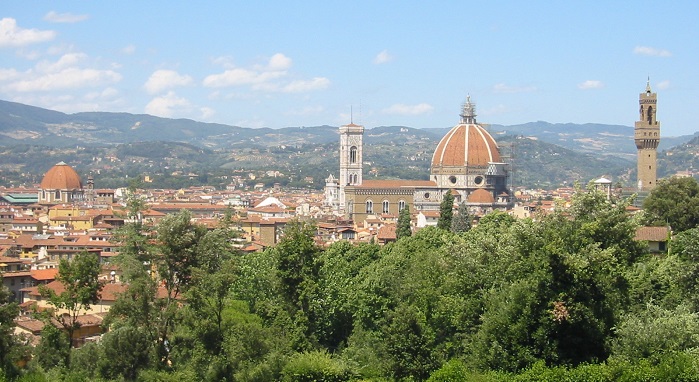
Your virtual Italy vacation continues and Thor and I visit the Florence Duomo and two versions of The Last Judgement.
NOTE: Since European travel is still tenuous with the pandemic continuing, I’m continuing my blog series offering a virtual vacation and time-travel to my first big trip with Thor in 2008. Italy! After starting with highlight photos posted here on Saturday, Jan. 30, I’ll now resume every week (after the blogging detour in real time to Hawaii). Join us in Rome, Florence, Cinque Terre, Venice, and Milan. Buon viaggio!
The Piazza del Duomo offers the monumental Cathedral of Santa Maria del Fiore, commonly called the Florence Duomo for the distinctive dome. The cathedral is the 4th largest Christian church in the world, and it is immense, able to hold 20,000 people inside.
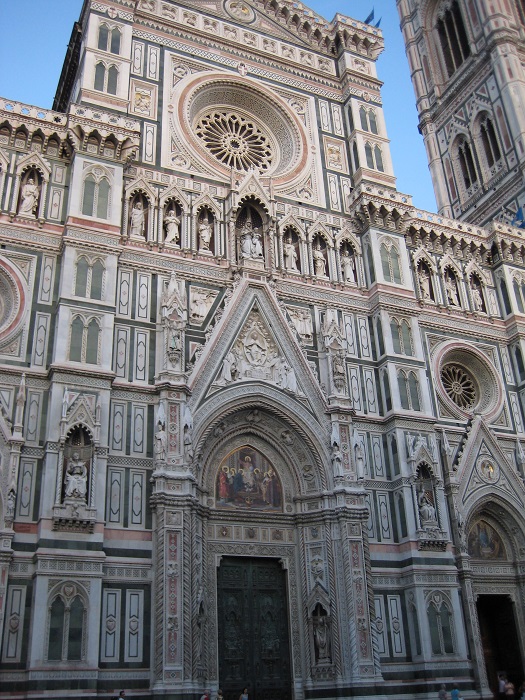
Building began in 1296, on the site of a much earlier church, and the cathedral was consecrated in 1436 by Pope Eugenius IV. Several phases and styles over the centuries resulted in a Gothic Cathedral with Renaissance additions, finally furnished with a new Gothic Revival facade in the 19th century. The elaborate facade is beautifully gleaming with marble in tones of green, pink, and white, dedicated to the Mother of Christ. The famous dome designed by Filippo Brunelleschi was added in the 15th century. It was an innovative design, the first large octagonal dome erected without scaffolding, drawing on the ancient Roman Pantheon for structural inspiration. There are two layers, the outer one of brick, with reinforcing ribs and wooden “chains” supporting and separating the two layers.
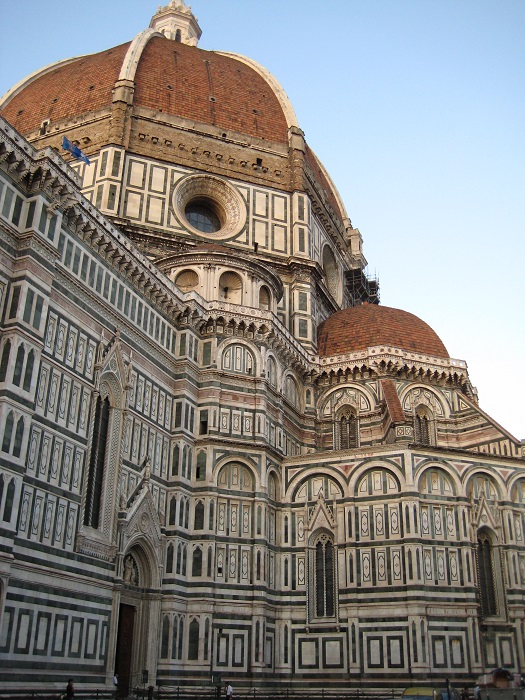
Giotto’s Bell Tower set the design tone of colored marble, itself inspired by the decoration of the Baptistry adjacent on the piazza. (More about the Baptistry later.)
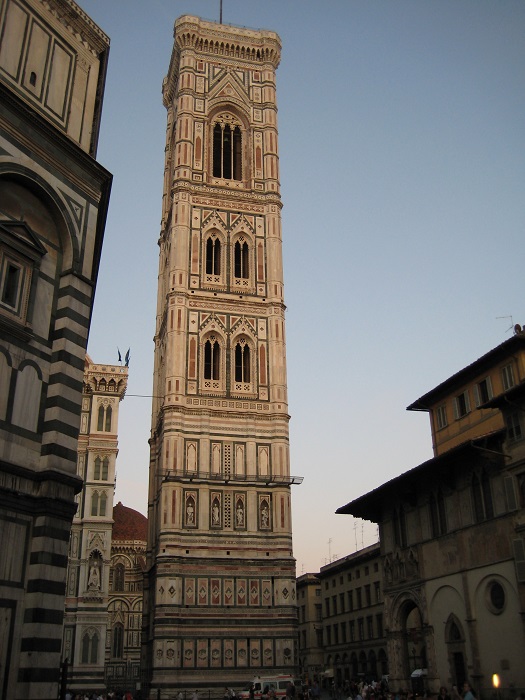
Again I lament my lost photos, as I rely on Thor’s camera shots for this series. He’s often more interested in stones and detail quirks of buildings than bigger pictures, so all he had of the soaring interior was this shot of decorative marble flooring. The vast Gothic interior is relatively bare in order to conform to the austerity of religious life at the time, as promoted by Girolamo Savonarola. (See the site of his “Bonfire of the Vanities” and his execution in last week’s blog post here.)

If you’d like to see more of the interior, here’s a link: https://www.visitflorence.com/florence-churches/duomo.html
Meanwhile, let’s climb up into the dome via a winding series of vary narrow stairs squeezed between the two layers of the dome structure. If you’re claustrophobic, don’t even think about it. But the stifling climb was worth it to see up close the frescoes of The Last Judgement decorating the dome’s interior.
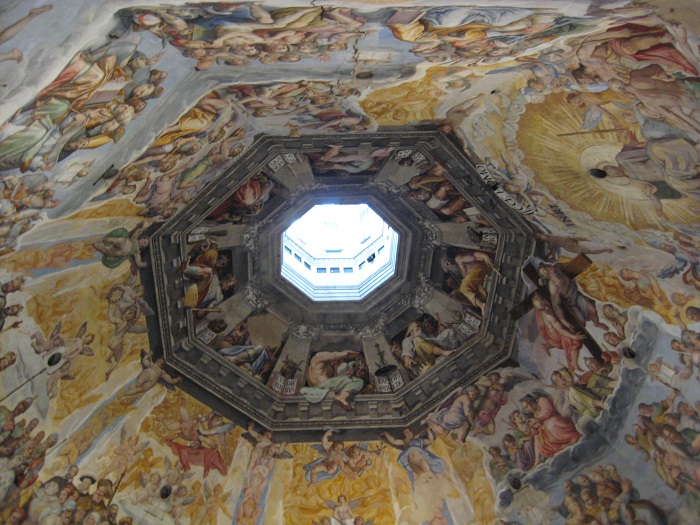
The dome had remained unfinished after Brunelleschi’s death in 1446. His plans called for the interior to be coated in gold leaf, but it was simply whitewashed instead. Then, in 1572, Cosimo I de’ Medici (the ruling family) commissioned Giorgio Vasari to decorate it with frescos on themes from Dante’s Divine Comedy.
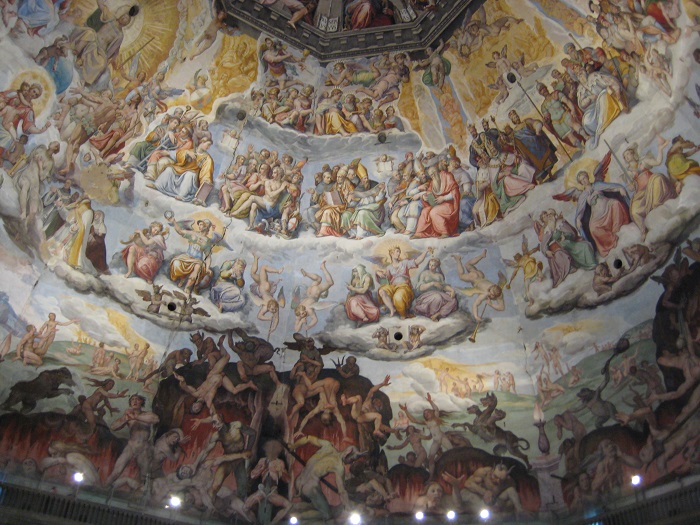
He followed the tiered layout from the older, adjacent Baptistry, with its mosaic-decorated interior dome of The Last Judgement. From the top down are holy figures and some worthies of Florence, saints, angels, and a larger panel of Christ in Glory between the Madonna and St. John. On the lower levels, the lost sinners fall into the depths of Hell and some graphically imaginative torments.
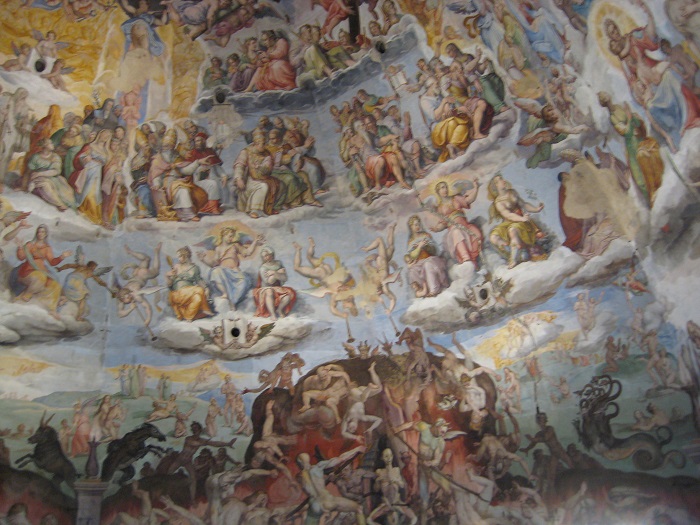
The Devil has a taste for human flesh:
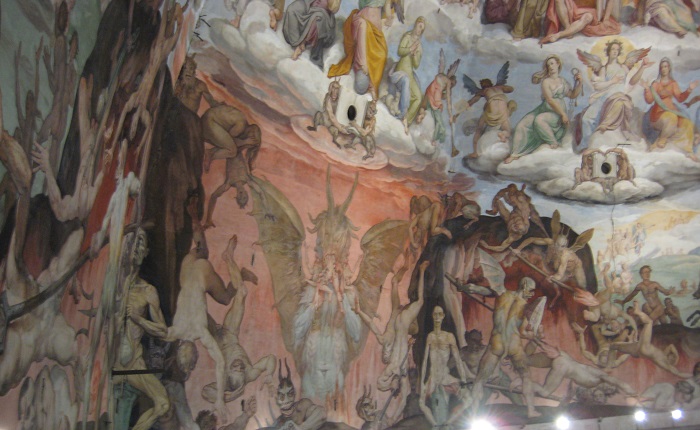
Thor and I found the weird, hellish creatures such as the skeleton Reaper and the giant squid fascinating.
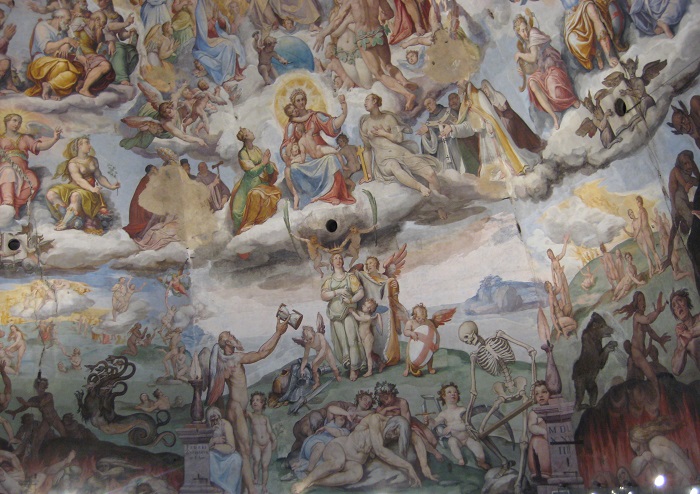
The artist Vasari died with only a third of the work (the upper portions) completed in this 4,000-square-meter “canvas.” The work was finished by Federico Zuccari, who veered from the traditional Tuscan method from the Middle Ages, instead adopting a more crude style used in theatrical backdrops. It proved effective in allowing the dramatic scenes to be seen more clearly from the distance below in the cathedral. And he really went all out with the tortures he portrayed.
I’ve never been a fan of the Church tradition of sin and punishment, but I have to admit that I wouldn’t shed many tears if certain politicians and CEOs of our times were to find their just rewards.
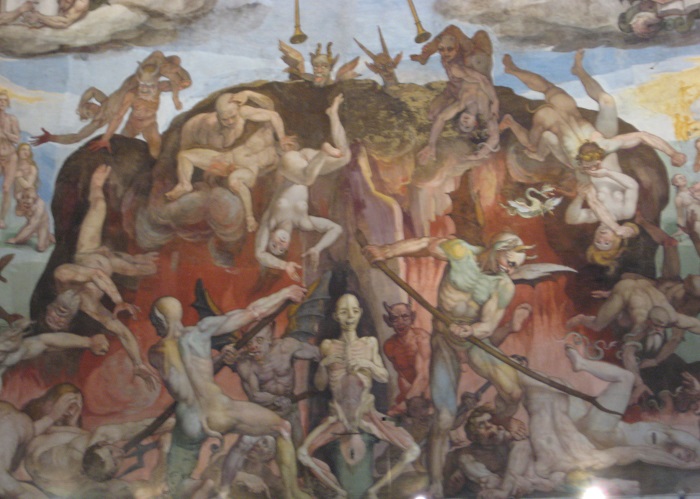
Thor descends through the labyrinth, at peril of head-bashing:
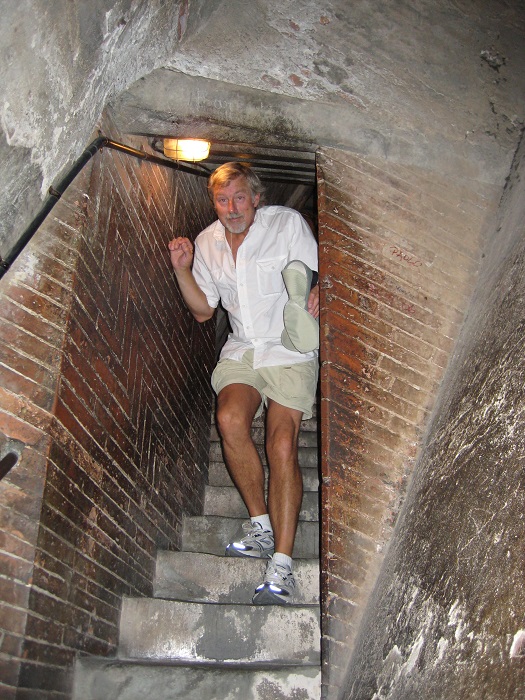
The sweaty climb during a September heat wave also earned us some open air and fabulous views over the city.
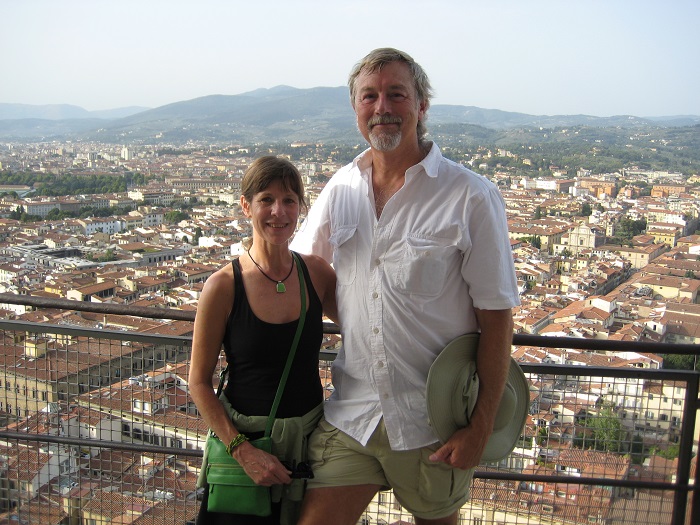

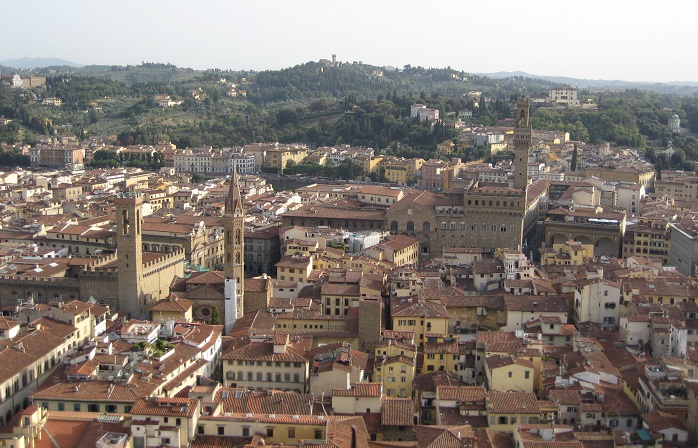
There are a Lot of churches in Florence.
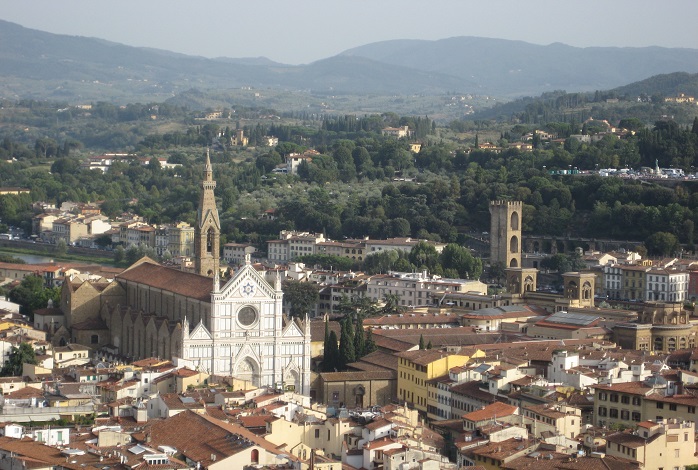
After arriving back at ground zero in the piazza, we crossed over to the octagonal Baptistry of St. John, with its own smaller dome and interior version of The Last Judgement.
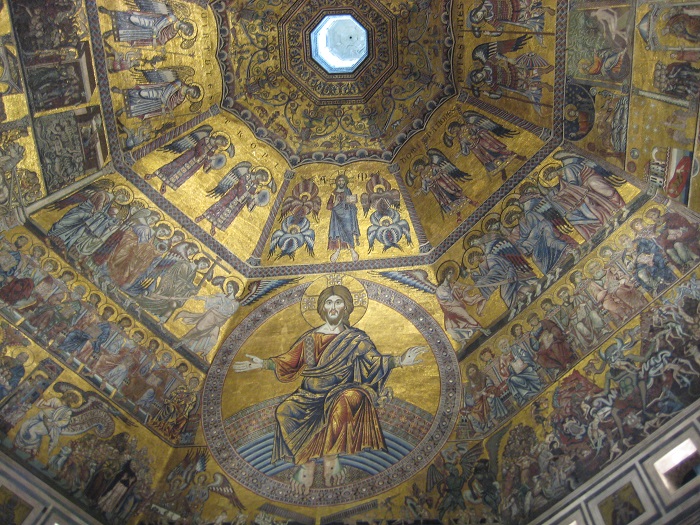
The Baptistry is one of the oldest buildings in the city, built between 1059 and 1128, in Florentine Romanesque style. The exterior decoration with colored marble was the model for the later cathedral facade. Legend has it that this was the site of an ancient temple to Mars, the god of war, which isn’t proven. But it is certain that the first baptistery was located here around 400 A.D., in the traditional octagonal shape. Dante Alighieri and many members of the Medici family were baptized here.
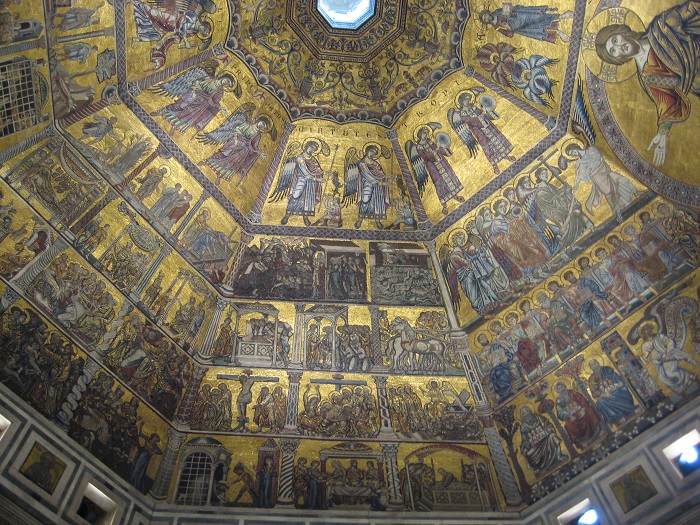
The images are truly amazing, given that it is all an intricate mosaic, started in 1225 by Franciscan Friar Jacobus. To my eye, the style appears similar to the Greek Orthodox icons in depictions of Christ and saints, but I haven’t seen that connection established.
Here’s another Devil hungry for human flesh:

Christ above the Devil is a common thread, with the pure souls ascending.
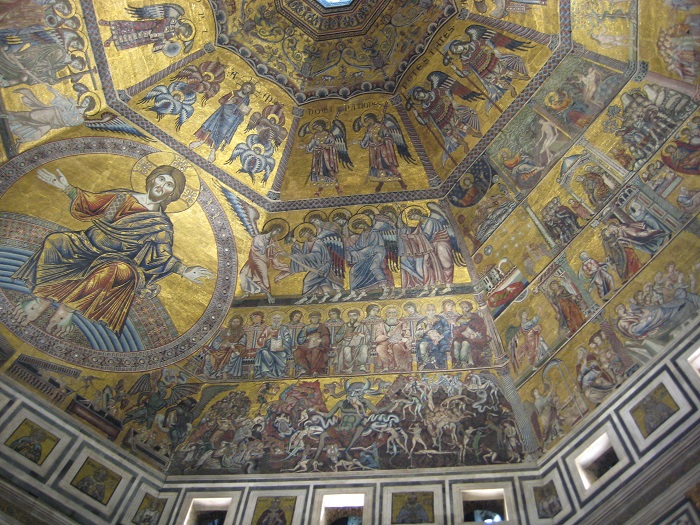
A glimpse of the interior of the Baptistry:

Next week: On a lighter note, some sights out and about in Florence.
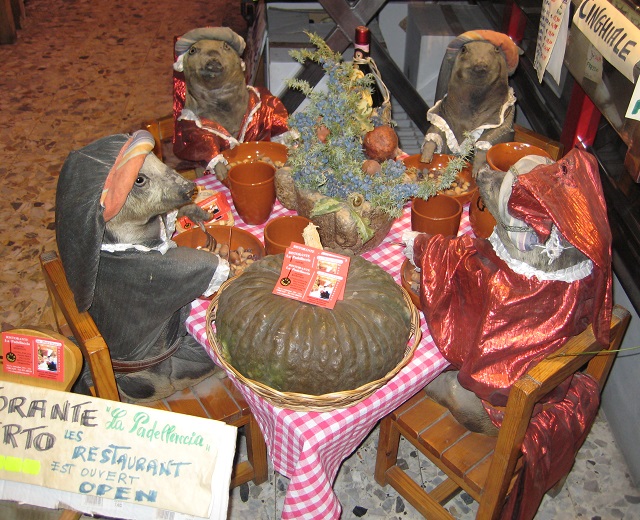
*****
You will find The Rambling Writer’s blog posts here every Saturday. Sara’s latest novel from Book View Cafe is available in print and ebook: The Ariadne Connection. It’s a near-future thriller set in the Greek islands. “Technology triggers a deadly new plague. Can a healer find the cure?” The novel has received the Chanticleer Global Thriller Grand Prize and the Cygnus Award for Speculative Fiction. Sara has recently returned from another research trip in Greece and is back at work on the sequel, The Ariadne Disconnect. Sign up for her quarterly email newsletter at www.sarastamey.com

It’s ironic that the Duomo is decorated inside with scenes from Dante, given that Dante was exiled from Florence (due to Politics) and wrote the Commedia while living in in Ravenna.
You mention modern politicians and CEOs – in fact the Inferno features many of Dante’s contemporaries (recently deceased or in some cases still alive) suffering for their misdeeds on earth. If you are especially wicked, Dante explains, your soul can go straight to Hell before death for punishment, while a demon inhabits your body on Earth (indistinguishable from the real thing).
Thanks, Anef! I knew that some Florence contemporaries were pictured among the saints and angels, but didn’t remember that about the Commedia’s named fallen. Do you know if any of them are pictured in the Duomo fresco?